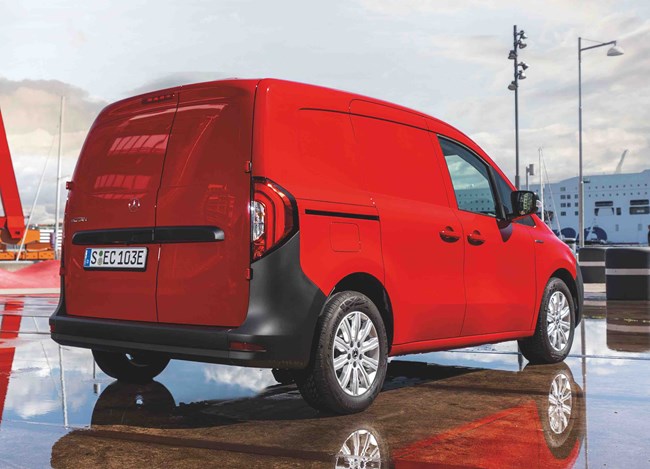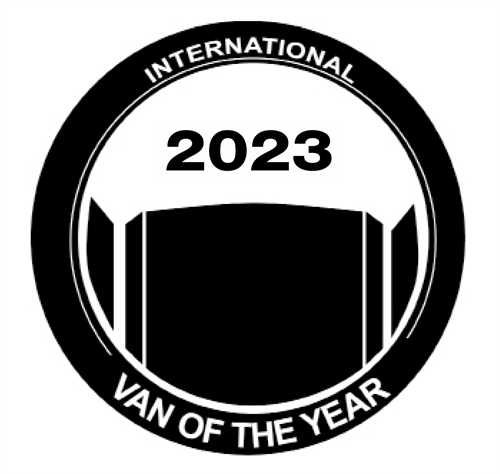- ETRUX launches new Ford E-Transit Trizone
- Renault gives UK debut to Master E-Tech at CV Show
- Isuzu D-Max long-term test – Latest Report
- Isuzu D-Max V-Cross Steel Edition revealed
- IVOTY Report: Stellantis explores the hydrogen proposition
- New Maxus EVs include eDeliver 5 van
- Used LCV values reach six-month high
- ADVERTISEMENT FEATURE: IVECO Daily Mission Awards 2024 Q2 Round-up: Grounds Maintenance & Forestry
- Stellantis Pro One electric vans review
- Mitie adds 5,000th EV to fleet
IVOTY Report: Mercedes plugs in the Citan
Date: Friday, May 19, 2023 | Author: George Barrow
The three-pointed star brand bided its time but has finally electrified its compact van.

The small van segment has been the battleground of the electric van market for years but a prominent name has been missing from the arena.
Mercedes-Benz chose to electrify their larger vans first. Starting with the eVito in very limited numbers nearly a decade ago. More recently, the eVito has been relaunched and improved further, while the eSprinter has been launched and has a scheduled refresh for next year. An electric Citan, however, has been conspicuous in its absence. That’s despite sharing its platform from launch with the Renault Kangoo, one of the first light commercial vehicles to be electrified. There may not have been a Citan based on the Renault Kangoo ZE, but with Renault having totally transformed its small van chassis and relaunched its compact electric van offering as the Renault Kangoo E-Tech, the time is now right for Mercedes to finally sell an electrified Citan.
In comparison to the Vito and Sprinter, the Citan has always been a much smaller volume product. Electrifying it was not a top priority. However, as the market for EVs has matured, an eCitan has become a missing piece in the Mercedes’ puzzle and the brand’s push to full electrification and EV only sales.
Like the diesel Citan, the eCitan is largely Mercedes’ own doing. Some homework has been copied – the chassis, electric motor and batteries are all Renault’s own – but there’s been as much personalisation as possible. As with the diesel model, there’s unique suspension and steering setups, and an enhanced level of safety systems over and above the Kangoo. The appearance is also a unique Mercedes design, but is limited to the front half of the vehicle. Likewise, the interior is crammed full of familiar Mercedes designs, not least the MBUX system (optional), but there are still a few telltale Renault components hovering under your immediate eyeline.
Power comes from a 90kW motor producing 245Nm of torque. The 45kWh lithium-ion batteries are located under the floor, which means the Citan’s 2.9m3 capacity is unchanged. A long-wheelbase model with a higher gross weight, 3.6m3 capacity and 722kg payload will be added later in the lifecycle, but for now the standard length Citan is available with a 544kg payload.
Charging has a maximum output of up to 75kW with a DC charger and will take just 38 minutes to bring the battery level from 10 to 80%. There’s also the option of AC charging, with 11kW or optional 22kW abilities. A full charge is said to give a range of up to 174 miles.
In terms of interior specification, the difference between electric and diesel is also minimal, but there is the inclusion of important electric powertrain specific details in the digital display giving details of the range and energy consumption. There’s also the choice of two driving modes, Comfort and Eco, accessible through a button on the dash. The eCitan starts in Comfort as standard but can be switched into Eco to improve range by limiting power delivery.

The level of regenerative braking can also be changed by the driver with three different amounts of energy recuperation possible. The eCitan gets D-, D and D+ modes with the minus option increasing the regeneration to its highest, and quite severe, setting, the regular D mode leaving a normal but still forceful amount of regeneration and D+ allowing the vehicle to coast.
Although the modes and regeneration levels are named similarly to the larger vans, they are slightly different, with fewer settings than Mercedes’ own vans that get three driving modes and five levels of regeneration. Instead, the settings match that of the Kangoo, which also gets an Eco driving mode and three levels of regen.
Aside from the appearance of the exterior and interior, there are other ways in which Mercedes has tried to make the eCitan its own compared to the Kangoo. The springs, shock absorbers and stabilisers of the Citan are all different, which leads to a different feel in ride and handling. Many of the bits underneath might be the same, but there’s a subtlety in the way the Mercedes drives, it’s smoother and more comfortable as a result. Like the Kangoo it is also exceptionally quiet – perhaps even more so than the French brand’s van. The electric motor delivers a good performance and while it’s not lightening quick compared to many electric vehicles it’s still plenty fast enough for a small van with a modest payload.
The new Citan is a massive step up from the old model, so to base an electric vehicle on such a vastly improved van means that it is already well on the way to success. It’s also slightly different to the other electric Mercedes, and while that shouldn’t be considered a bad thing – the larger vans do, after all, have their own issues, namely with range and payload, as they are conversions of diesel vans rather than on an EV prepared platform like the eCitan is – there are elements of the Mercedes way of doing electrification that the eCitan misses. Whether or not eCitan drivers will really care about missing
out on a few regenerative braking settings and a driver mode is immaterial as the line-up is now complete with a fully electrified small van – and a good one too that offers pound-for-battery-pound better range than the bigger vans.
The eCitan is as convincing an EV as the small segment has to offer. Only pricing might be the difference between buying one or not when it arrives at the end of this year. With German models set to be priced at €36,000 (£31,000) before taxes, a UK eCitan could be quite pricey.
EQT - the eCitan with luxury lifestyle leanings
Once upon a time there wasn’t a household in the land with occupants over a certain age that didn’t own (or had considered owning) a multipurpose van-based MPV. Passenger versions of the Renault Kangoo and Citroën Berlingo were bestsellers, but then SUVs of all sizes arrived and the market dwindled. Despite the dip, van manufacturers have continued to make passenger versions of their vans, but most err towards the utility end of the spectrum rather than the premium. That’s not the case, however, with the Mercedes-Benz EQT – an eCitan with luxury lifestyle leanings, or the electrified version of the diesel T-Class.
It gets the same 45kWh battery as the eCitan and 90kW electric motor producing 245Nm. Launched as a five-seater with a long-wheelbase seven seven-seater to follow, the EQT – which adopts the EQ naming strategy of other electrified Mercedes passenger cars – gets an upmarket almost suede-like trim on the doors and dash, with synthetic leather elsewhere. It’s a high-end cabin befitting of a car with inductive mobile phone charging, MBUX 7in touchscreen, three Isofix child seat mounts and nice to have functions like keyless start and automatic wipers and headlights. It also has a heat pump for the air conditioning, improving its suitability for cold climates and increasing cabin heating efficiency.
As pleasant as the EQT is, though. It still feels like a van and its boxy interior is nosier than expected, despite the electric motor and premium materials. Rear seat space is also quite limited, but the raised seating does mean that the view for occupants in the rear is good. There’s plenty of rear storage, but roof rails are an option for extra capacity along with an additional towing pack. The Renault components mentioned in the eCitan are even more noticeable against the upgraded premium Merc interior tweaks, which is a let-down in what is, overall, a smart adaptation of a van platform.
Safety first for Mercedes’ shared vans
Differentiating your new products isn’t always easy, but Mercedes seems to have hit upon a formula for its shared products. The first generation Citan paid lip-service to the idea that you could change the front end and tweak the handling to create an entirely different feeling van.
The X-Class pick-up truck took that idea further still and introduced significant new interior differences over the Nissan Navara pick-up. This lastest eCitan van and EQT passenger car go even further in their attempts to separate out the Mercedes product from the Renault donor vehicle, however, the key differentiator is not just cosmetic. Safety systems are the Mercedes USP of choice.
While the Renault Kangoo is no slouch when it comes to active and passive safety systems, Mercedes has ramped up the standard fitment of them. There are a total of 20 ADAS systems available on the Kangoo E-Tech and the eCitan gets most as standard. Perhaps more impressive, however, is that there are seven airbags on the EQT with front airbags, windowbags, thorax sidebags and a unique additional centre airbag. In the event of a severe side impact, the centre airbag appears between the front seats to prevent two heads coming together with one another. You can’t put a price on safety, so while it may seem almost insignificant to some, it’s platform sharing with a notable difference.
George Barrow is the UK jury member for the International Van of the Year Award.
View The WhatVan Digital Edition


